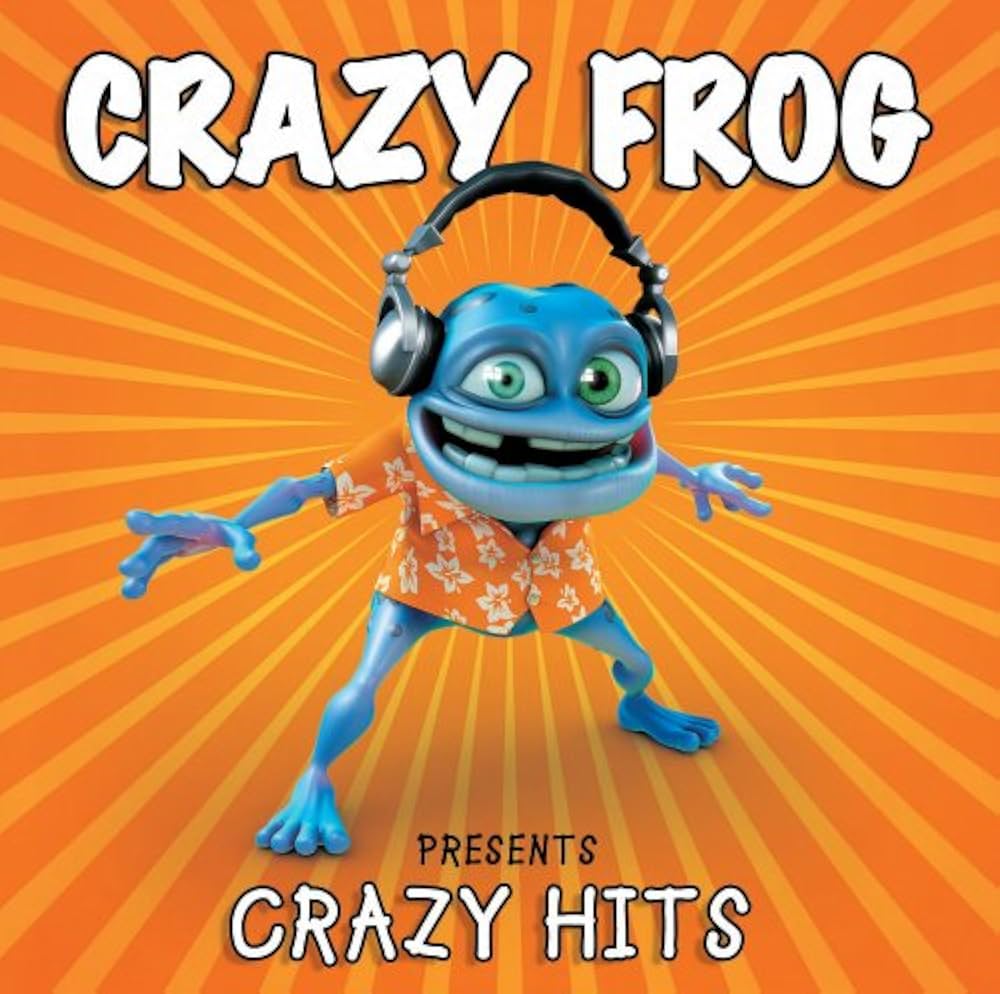Revisiting The Ringtone Era: Crazy Frog’s Hits Album Came Out 20 Years Ago Today

The Annoying Thing. That was its original name. Crazy Frog, the noisy little animated character that has delighted and irritated millions around the world, was annoying by design. In late 2003, Swedish animator Erik Wernquist made a 43-second video featuring a goofy little frog wearing a vest and a helmet with goggles (and no pants) making noises as he revs up an imaginary vehicle – and then speeds off, leaving a trail of exhaust fumes.
Less than two years after Wernquist created that crazy frog, he was a major pop star whose album Crazy Frog Presents Crazy Hits, released 20 years ago today, charted around the world. These days, it often appears on lists of the worst albums ever made. Crazy Frog’s signature song was a cover of “Axel F,” Harold Faltermeyer’s 1984 instrumental theme from Beverly Hills Cop, with the frog doing his nonsensical “ring ding ding ding bem bem bem” thing over the song’s deathless synth riff. The “Axel F” video features a callback to Crazy Frog’s original name: a wanted poster referring to him as “the most annoying thing in the world.”
You’re doubtlessly familiar with Crazy Frog if you’ve been alive anywhere in the western world in the last two decades, but he was a little less omnipresent in America than elsewhere. “Axel F” peaked at #50 on the Hot 100 and Crazy Hits reached #19 on the Billboard 200, whereas both were Top 10 hits in most territories across Europe. In the UK, Coldplay had to settle for #2 for “Speed of Sound,” the lead single from the highly anticipated X&Y, when “Axel F” blocked it from #1.
Cartoon characters have a long history on the pop charts, from Alvin & The Chipmunks to Gorillaz. There are currently eight songs on the Hot 100, including one in the Top 5, by the fictional groups from Netflix’s animated feature KPop Demon Hunters. But Crazy Frog wasn’t launched into mass consciousness by a movie or even an established recording artist. The German company Jamba, known in America as Jamster, made Crazy Frog famous to sell phone ringtones, which by 2005 had become a multi-billion dollar business. You may have never heard Crazy Frog on the radio, but you probably heard his weird little voice coming out of someone’s phone many times in 2005.
In the ’90s, monophonic ringtones were a fun novelty, cute and simple little melodies you could pick your phone to make instead of a harsh clarion when someone’s calling you. Drake’s current hit “Nokia” is named after the largest mobile phone vender in that pre-iPhone era and features an interpolation of one of Nokia’s signature ringtones. The first downloadable ringtone service was introduced by a Finland mobile provider in 1998, and within a few years America had fallen in love with the novelty of personalized ringtones.
By the mid-2000s, polyphonic ringtones and master ringtones, featuring MP3-quality snippets of the master recordings of your favorite pop hits, had changed the game. Ringtones typically cost at least twice as much as the 99-cent songs on iTunes, making it a cash cow for the hip-hop acts whose catchy songs were sometimes derided as “ringtone rap.” The top two ringtones in America in 2005 were 50 Cent’s “Candy Shop” and Lil Jon’s “Lovers & Friends.” But right behind them were the 8-bit bleeps of the Super Mario Bros. theme song from the old Nintendo game. The Crazy Frog version of “Axel F” was the perfect storm, a funny new hi-fi version of one of the most popular monophonic ringtones of a nostalgic ’80s track.
Crazy Hits is a funny little artifact of that fleeting moment when ringtones were king. Ministry Of Sound, the multimedia dance music company that had grown out of the influential London nightclub of the same name, released the album, but it had absolutely nothing to do with dance music in any halfway reputable sense. On the cover, as in The Annoying Thing, a little frog dick and scrotum is visible between his legs. This genitalia wasn’t present in all depictions of Crazy Frog, but it’s pretty insane that it was present in some of them.
Most of the tracks are covers of familiar hits, following the “Axel F” template. There’s an emphasis on jock jams like Vengaboys’ “We Like To Party” or Reel 2 Real’s “I Like To Move It,” which had recently received another kid-friendly cartoon animal makeover in the 2005 box office hit Madagascar. There’s a Baha Men rewrite called, you guessed it, “Who Let The Frog Out?” The follow-up single to “Axel F” was a cover of another old instrumental hit, “Popcorn,” made famous by Hot Butter in 1972. A Christmas edition of Crazy Hits was issued with a Crazy Frog rendition of “Jingle Bells.”
My favorite track on Crazy Hits is an afterthought buried toward the end, “Crazy Sounds – Acapella,” the moment where the frog is finally freed from any semblance of rhythm or melody and just gets to ramble on unaccompanied for three endless minutes. I’m sure the producers were encouraging people to make their own remixes and memes with the Crazy Frog voice, but I find the track kind of hypnotic and almost soothing as a comedown after those relentless Eurodance anthems. You could say that Crazy Hits wasn’t meant to be listened to front-to-back as an album, and that’s probably true. But in 2005, music sales figures still represented actual purchases, so this was not the illusory modern chart boost of an album with one single that people like to stream: Over a million people spent about $10 at a CD store or on iTunes to own an hour of frog babble.
The road to the Crazy Frog zeitgeist was paved with several people making something silly to amuse and annoy other people with, first for fun and then profit. It all began in 1997, when Swedish teenager Daniel Malmedahl made some funny sounds with his voice, mimicking the sound of a moped engine. The recording he posted online snowballed in popularity after he was featured on Swedish television. After an MP3 of Malmedahl’s voice circulated on filesharing services, Erik Wernquist took the recording and pitched it up for The Annoying Thing. That video was in the demo reel that got him hired by Kaktus Film, the company that produced all subsequent Crazy Frog videos and commercials.
Jamba approached Wernquist about making Crazy Frog ringtones. At the time, a non-froggy “Axel F” ringtone was their top seller, so Crazy Frog’s debut single was a mercenary mashup of two hot properties. Berlin producers Reinhard “Voodoo” Raith and Wolfgang Boss created the bulk of Crazy Frog’s discography, and “Axel F” author Harold Faltermeyer is also German. Surprisingly, Germany is one of the only countries in Europe where Crazy Frog didn’t go to #1, with “Axel F” stalling at #3. Another animated animal Jamba created to sell ringtones, a bunny named Schnuffel, was far more popular in Germany, topping the charts for eight weeks in 2008. The most severe case of Crazy Frog fever was in New Zealand, where three of his singles went to #1 and Crazy Hits went triple platinum.
Ringtone revenue peaked in 2006, and almost immediately began a sharp decline after Apple introduced the iPhone in early 2007, rendering old school ringtones quaint and obsolete. Crazy Frog’s popularity inevitably cooled as well, and Jamba and Ministry Of Sound stopped pumping out Crazy Frog content after his third album, 2009’s Everybody Dance Now, missed the charts everywhere but France.
A funny thing happened over the last 15 years, though. People kept on listening to Crazy Frog. He’s thriving on platforms that barely existed in the ringtone era. Crazy Frog’s YouTube channel has over 10 billion views, making him the 76th most popular musical artist on the site, just a few spots behind superstars like Nicki Minaj and Miley Cyrus. He feels like less of an anomaly in the TikTok era, when brief viral snippets can launch a song on the charts, creating a new wave of obnoxious novelty hits. Raith and Boss eventually saw that there was more money to be made, and four new Crazy Frog singles have been released since 2021, but none of them has really caught fire or led to a new album. Yet.






